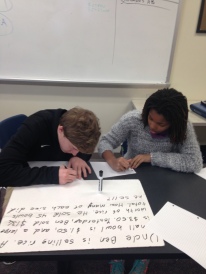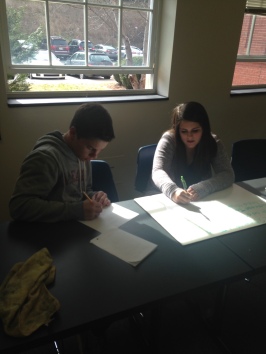I love when my students are engaged and visually learning. After Julie Reulbach told me about how she used Play-doh to create 3D shapes with her students, I decided to try it out. I had students work in groups of two to create 3D shapes.
Supplies per group:
- One fun-sized Play-doh
- Ruler
- Plastic knife
Students were given the following instructions
- Create a square prism
- Using your ruler, cut your shape into 1 cm pieces. Cut it away that all of your pieces are the same shape. Specify that you can only cut once to make the shape.
- Next, we discussed finding the area of one piece and then multiplying it by the number of pieces to find the volume. They realized that the number of pieces their prism was cut into was the “height”.
We repeated this with a triangular prism and cylinder. Students came up with the formula that volume= area base*height.
Next, I had students create a cone and asked them to cut it into identical shapes. They realized they couldn’t. I wish that I had 3D solids at this point in class (I got some later), but I did the next best think by showing them a video.
I first started out by asking if they thought a cone could relate to any of the other shapes we’ve talked about. A cylinder quickly became the winner because they both of circular bases. I then asked how much bigger did they think the cylinder was compared to the cone. After taking classroom bets we watched a video using corn kernels from a cylinder to fill up 3 cones. This helped us derive the equation for the volume of a cone. We did this same thing for finding the formula for a pyramid.
This play-doh activity really helped my students visualize the formulas and understand that the height of the pyramid didn’t always go from top to bottom. We described the heig ht as the direction we’d slice the shape to create congruent shapes.
ht as the direction we’d slice the shape to create congruent shapes.
The next day, I did have 3D solids and set of stations around the room.
Station 1: Cone and Cylinders
Station 2: Triangular and Square Pyramids and their prisms.
Stations 3: Octagonal Pyramid and Octagonal Prism.
Station 4: Half Sphere and Cylinder
For stations 1-3, I had students first find the volume of the shapes algebraically. They then fill up the shapes with water and measured the volume of the water using graduated cylinders. They loved seeing their math match up (close enough). This also gave us a chance to talk about percent error (spilling water).
 For station 3, I first had them fill up the half sphere with water and measured the water with the graduated cylinder. Next, they had to figure out how many half spheres it took to fill up their cylinder. The cylinder was the same height of the half sphere.
For station 3, I first had them fill up the half sphere with water and measured the water with the graduated cylinder. Next, they had to figure out how many half spheres it took to fill up their cylinder. The cylinder was the same height of the half sphere.
It was then up to the students to derive the formula for a half sphere, then a full sphere. The hardest part for them was making the connection that the height was also the radius.
I loved these water stations. Students got to visualize the formulas for the second time, they got to practice finding volume, and they got to derive the formula for a sphere.
After class, I asked my students if they would have liked doing the water activity on the first day. They told me they liked doing the water later in the lesson because they had a day to let the play-doh formulas sink in and they could reaffirm what they knew and discovered something new.









































